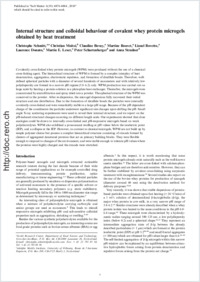Internal structure and colloidal behaviour of covalent whey protein microgels obtained by heat treatment
- Schmitt, Christophe Nestlé Research Center, Department of Food Science and Technology, Switzerland
- Moitzi, Christian Adolphe Merkle Institute, University of Fribourg, Switzerland
- Bovay, Claudine Nestlé Research Center, Department of Food Science and Technology, Switzerland
- Rouvet, Martine Nestlé Research Center, Department of Food Science and Technology, Switzerland
- Bovetto, Lionel Nestlé Research Center, Department of Food Science and Technology, Switzerland
- Donato, Laurence Nestlé Research Center, Department of Food Science and Technology, Switzerland
- Leser, Martin E. Nestlé Research Center, Department of Food Science and Technology, Switzerland
- Schurtenberger, Peter Adolphe Merkle Institute, University of Fribourg, Switzerland
- Stradner, Anna Adolphe Merkle Institute, University of Fribourg, Switzerland
-
18.08.2010
Published in:
- Soft Matter. - 2010, vol. 6, no. 19, p. 4876-4884
English
Covalently cross-linked whey protein microgels (WPM) were produced without the use of a chemical cross-linking agent. The hierarchical structure of WPM is formed by a complex interplay of heat denaturation, aggregation, electrostatic repulsion, and formation of disulfide bonds. Therefore, well-defined spherical particles with a diameter of several hundreds of nanometers and with relatively low polydispersity are formed in a narrow pH regime (5.8–6.2) only. WPM production was carried out on large scale by heating a protein solution in a plate-plate heat exchanger. Thereafter, the microgels were concentrated by microfiltration and spray dried into a powder. The spherical structure of the WPM was conserved in the powder. After re-dispersion, the microgel dispersions fully recovered their initial structure and size distribution. Due to the formation of disulfide bonds the particles were internally covalently cross-linked and were remarkably stable in a large pH range. Because of the pH dependent charge of the constituents the particles underwent significant size changes upon shifting the pH. Small angle X-ray scattering experiments were used to reveal their internal structure, and we report on the pH-induced structural changes occurring on different length scale. Our experiments showed that close analogies could be drawn to internally cross-linked and pH-responsive microgels based on weak polyelectrolytes. WPM also exhibited a pronounced swelling at pH values below the isoelectric point (IEP), and a collapse at the IEP. However, in contrast to classical microgels, WPM are not build up by simple polymer chains but possess a complex hierarchical structure consisting of strands formed by clusters of aggregated denatured proteins that act as primary building blocks. They were flexible enough to respond to changes of the environment, and were stable enough to tolerate pH values where the proteins were highly charged and the strands were stretched.
- Faculty
- Faculté des sciences et de médecine
- Department
- AMI - Soft Nanoscience
- Language
-
- English
- Classification
- Physics
- License
- License undefined
- Identifiers
-
- RERO DOC 20909
- DOI 10.1039/c0sm00220h
- Persistent URL
- https://folia.unifr.ch/unifr/documents/301616
Statistics
Document views: 120
File downloads:
- str_isc.pdf: 305
